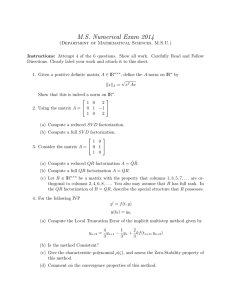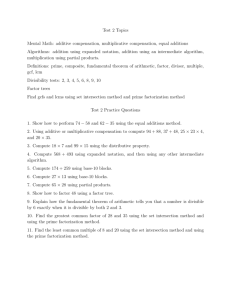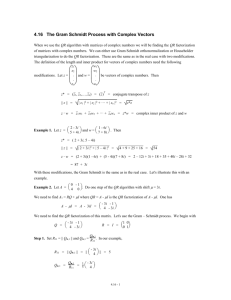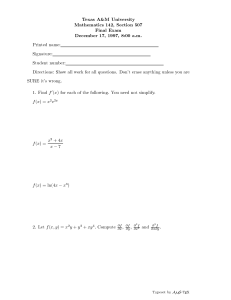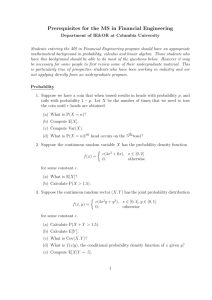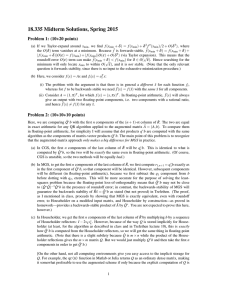18.335 Midterm, Spring 2015 Problem 1: (10+(10+10) points)
advertisement
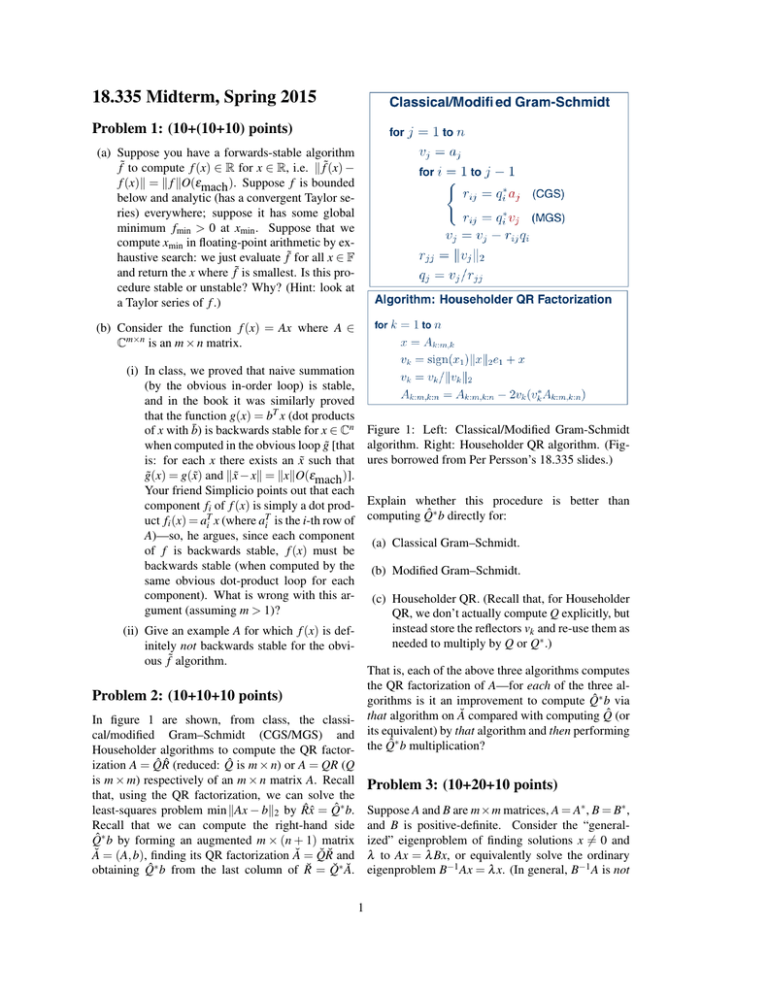
18.335 Midterm, Spring 2015 Problem 1: (10+(10+10) points) (a) Suppose you have a forwards-stable algorithm f˜ to compute f (x) ∈ R for x ∈ R, i.e. k f˜(x) − f (x)k = k f kO(εmach ). Suppose f is bounded below and analytic (has a convergent Taylor series) everywhere; suppose it has some global minimum fmin > 0 at xmin . Suppose that we compute xmin in floating-point arithmetic by exhaustive search: we just evaluate f˜ for all x ∈ F and return the x where f˜ is smallest. Is this procedure stable or unstable? Why? (Hint: look at a Taylor series of f .) (b) Consider the function f (x) = Ax where A ∈ Cm×n is an m × n matrix. (i) In class, we proved that naive summation (by the obvious in-order loop) is stable, and in the book it was similarly proved that the function g(x) = bT x (dot products of x with b̄) is backwards stable for x ∈ Cn when computed in the obvious loop g̃ [that is: for each x there exists an x̃ such that g̃(x) = g(x̃) and kx̃ − xk = kxkO(εmach )]. Your friend Simplicio points out that each component fi of f (x) is simply a dot product fi (x) = aTi x (where aTi is the i-th row of A)—so, he argues, since each component of f is backwards stable, f (x) must be backwards stable (when computed by the same obvious dot-product loop for each component). What is wrong with this argument (assuming m > 1)? Figure 1: Left: Classical/Modified Gram-Schmidt algorithm. Right: Householder QR algorithm. (Figures borrowed from Per Persson’s 18.335 slides.) Explain whether this procedure is better than computing Q̂∗ b directly for: (a) Classical Gram–Schmidt. (b) Modified Gram–Schmidt. (c) Householder QR. (Recall that, for Householder QR, we don’t actually compute Q explicitly, but instead store the reflectors vk and re-use them as needed to multiply by Q or Q∗ .) (ii) Give an example A for which f (x) is definitely not backwards stable for the obvious f˜ algorithm. That is, each of the above three algorithms computes the QR factorization of A—for each of the three algorithms is it an improvement to compute Q̂∗ b via that algorithm on Ă compared with computing Q̂ (or its equivalent) by that algorithm and then performing the Q̂∗ b multiplication? Problem 2: (10+10+10 points) In figure 1 are shown, from class, the classical/modified Gram–Schmidt (CGS/MGS) and Householder algorithms to compute the QR factorization A = Q̂R̂ (reduced: Q̂ is m × n) or A = QR (Q is m × m) respectively of an m × n matrix A. Recall that, using the QR factorization, we can solve the least-squares problem min kAx − bk2 by R̂x̂ = Q̂∗ b. Recall that we can compute the right-hand side Q̂∗ b by forming an augmented m × (n + 1) matrix Ă = (A, b), finding its QR factorization Ă = Q̆R̆ and obtaining Q̂∗ b from the last column of R̆ = Q̆∗ Ă. Problem 3: (10+20+10 points) Suppose A and B are m×m matrices, A = A∗ , B = B∗ , and B is positive-definite. Consider the “generalized” eigenproblem of finding solutions x 6= 0 and λ to Ax = λ Bx, or equivalently solve the ordinary eigenproblem B−1 Ax = λ x. (In general, B−1 A is not 1 Hermitian.) Suppose that there are m distinct eigenvalues |λ1 | > |λ2 | > · · · > |λm | and corresponding eigenvectors x1 , . . . , xm . (a) Show that the λk are real and that xi∗ Bx j = 0 for i 6= j. (Hint: multiply both sides of Ax = λ Bx by x∗ , similar to the derivation for Hermitian problems in class.) (b) Explain how to generalize the modified Gram– Schmidt algorithm (figure 1) to compute an “SR” factorization B−1 A = SR where S∗ BS = I. (That is, the columns sk of S form a basis for the columns of B−1 A as in QR, but orthogonalized so that s∗i Bs j = 0 for i 6= j and = 1 for i = j.) Make sure your algorithm still requires Θ(m3 ) operations! (c) In exact arithmetic, what would S in the SR factorization of (B−1 A)k converge to as k → ∞, and why? (Assume the “generic” case where none of the eigenvectors happen to be orthogonal to the columns of B.) 2


